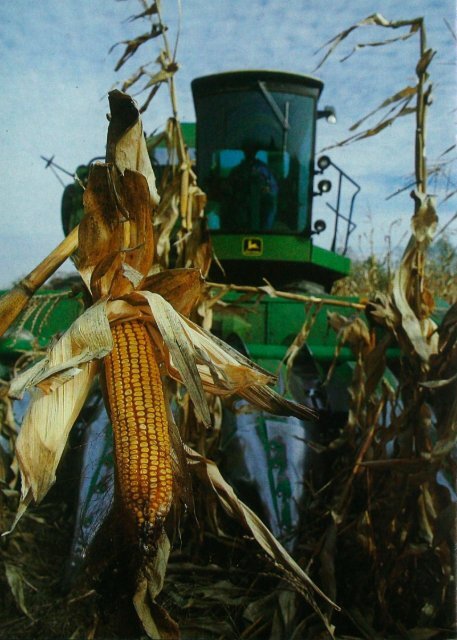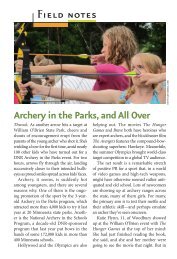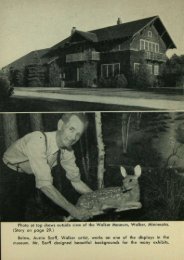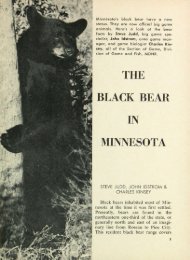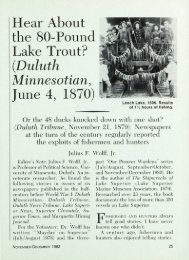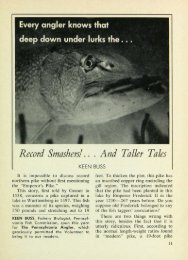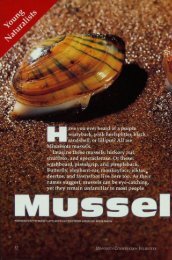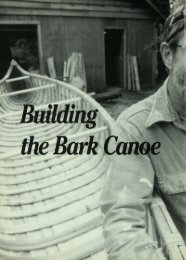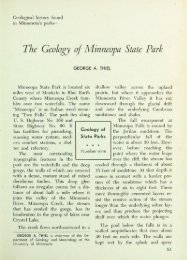364 Conservation Tillage Challenges the Moldboard Plow - webapps8
364 Conservation Tillage Challenges the Moldboard Plow - webapps8
364 Conservation Tillage Challenges the Moldboard Plow - webapps8
- No tags were found...
You also want an ePaper? Increase the reach of your titles
YUMPU automatically turns print PDFs into web optimized ePapers that Google loves.
Today, one acre in six in Minnesota is tilledby a new method of preparing ground for planting— conservation tillage. Farmers using thismethod, soil conservationists, and wildlifemanagers claim it offers advantages overtraditional moldboard plowing<strong>Conservation</strong> <strong>Tillage</strong><strong>Challenges</strong> <strong>the</strong><strong>Moldboard</strong> <strong>Plow</strong>Wayne Edgerton and Dean MillerTHEMOLDBOARD plow has been<strong>the</strong> primary tillage tool on Minnesotafarms since pioneers used itto break <strong>the</strong> virgin prairie sod morethan a century ago. But now manyfarmers are leaving <strong>the</strong>ir moldboardplows in <strong>the</strong> shed. The moldboardplow — conventional tillage — completelyturns <strong>the</strong> soil surface overand leaves it bare. Instead, morefarmers are turning to conservationtillage.<strong>Conservation</strong> tillage reduces soiland water loss because residue —old stalks, leaves, and roots fromprevious crops — is left on or near<strong>the</strong> soil surface. This residue actslike tiny umbrellas that shield <strong>the</strong>soil against erosive wind and rain. Inaddition, <strong>the</strong> residue makes miniaturedams that hold back excess rainfallso it soaks in and doesn t erode<strong>the</strong> soil.The term "conservation tillageincludes four major tillage systems:• No-till planting is performed inone operation. The specializedplanter cuts a slot in <strong>the</strong> soil, depositsseed and fertilizer, and <strong>the</strong>nfirms soil over <strong>the</strong> seed. About 90percent of <strong>the</strong> soil surface is left undisturbed• Strip-tillage planting is usuallycompleted in one operation. Thismethod normally uses a rotary tillerwhich mixes <strong>the</strong> residue and soil in<strong>the</strong> field to be planted. Twothirdsof <strong>the</strong> soil surface remainsundisturbed• Till planting scalps <strong>the</strong> areawhere <strong>the</strong> seed is planted andpushes <strong>the</strong> residue between <strong>the</strong>Late October corn harvest. A combine head approaches a corn cob on <strong>the</strong>Paul Bischoff farm near Stillwater. After harvest, crop residue left on <strong>the</strong>ground will reduce soil and water loss. (Photo by Tim Smalley, ONR.)37
<strong>Conservation</strong> <strong>Tillage</strong>planted rows. Again, two-thirds of<strong>the</strong> soil surface remains coveredwith residue• A chisel plow or disk tills <strong>the</strong> entiresoil surface before planting.Much of <strong>the</strong> residue remains on <strong>the</strong>surface.In 1982, Minnesota farmers usedconservation tillage on approximately3.6 million of <strong>the</strong> state's 23 millionacres of cropland, or about one acreout of every six. That's about twiceas many acres tilled by conservationmethods as in 1976.<strong>Conservation</strong> tillage is becomingmore popular in o<strong>the</strong>r states as well.The U.S. Department of Agriculturepredicts that, by <strong>the</strong> year 2000, conservationtillage will be used on over80 percent of <strong>the</strong> nation's cropland.Soil conservationists say that conservationtillage could significantlyreduce Minnesota's 100-million-tonper year soil loss. O<strong>the</strong>r benefits ofconservation tillage: savings in fuel,labor, time, and money; increasedwater filtration and less evaporation;fertilizer and pesticides less likely tobe washed oil <strong>the</strong> land; yields betterthan conventionally-tilled crops indry years and comparable in o<strong>the</strong>ryears; during fall and winter, morefood and cover available for wildlife.On DNR Land. The Departmentof Natural Resources encouragesconservation tillage on cropland thatit owns or administers. Much of <strong>the</strong>land is leased to farmers under acash or crop-share arrangement.Many of <strong>the</strong>se farmers use conservationtillage and are pleased with results.Paul Bischoff and his son Timplant corn on about 100 acres nearStillwater. The soil is mostly sandyloam with up to 12 percent slopes."We haven't moldboard-plowed<strong>the</strong> land in twelve years, Paul said."We tried chisel plowing for a coupleyears, but we weren t satisfiedwith <strong>the</strong> erosion control we weregetting. Some of <strong>the</strong> land had beennotorious for erosion, but we practicallyeliminated our erosion problemwhen we went to no-till four yearsago."The Soil <strong>Conservation</strong> Serviceestimated that with conventional tillagemethods, <strong>the</strong> land had a soil lossas high as 18 to 25 tons per acre peryear.No-till brought <strong>the</strong> soil loss downto fewer than five tons per acre peryear. (According to SCS guidelines,five tons per acre per year or less isgenerally acceptable.)The Bischoffs are sold on no-tillnow, even though <strong>the</strong>ir first twoyears were less than satisfactory.Four-bottom moldboard plow, left, turns over residue from last year's cropharvest and leaves raw soil, right, exposed to wind and water erosion.Above: A horse probably pulled this early model of a moldboard plow.39
<strong>Conservation</strong> <strong>Tillage</strong>"You need <strong>the</strong> right machine forno-till," Paul stated. "The planterwe used during our first two yearswas constantly plugging and ouryields were less than with conventionaltillage."In 1982 <strong>the</strong>y switched to a six-rowHiniker planter with John Deereplanter units and eliminated <strong>the</strong>irplugging problems. "We harvested95 bushels of corn per acre at 20 percentmoisture even though it was adry year. A neighbor's corn yieldedonly half as much with conventionaltillage methods. I don't think we'veever lost significantly in yield, evenwith our trials and tribulations <strong>the</strong>first year."We re saving at least 25 percenton fuel compared to our previoustillage methods. We plant <strong>the</strong> cropfor less than one gallon of fuel peracre.Wildlife like no-till, too. "We seelots of deer and pheasants in <strong>the</strong> falland winter," Paul added.Tim Bischoff mentioned ano<strong>the</strong>rbenefit. "Conventional tillage stirsup <strong>the</strong> soil. We had to pick up rocksevery year. We haven't picked upmany since we went no-till.Firm in Rain. Ano<strong>the</strong>r advantageof leaving old crop residue on <strong>the</strong>soil surface is that farmers can plantin wet wea<strong>the</strong>r when conventionaltillage equipment would get stuck."You can plant in rain, Tim said."The soil stays firm, and <strong>the</strong>re's littleapparent compaction problem."The soil will stay warmer if youdon't chop stalks, because <strong>the</strong> chopperjust spreads a layer of residueinsulation over <strong>the</strong> ground," he continued."Newer conservation plantersplant right through standingstalks without any problem.Doug Heim leases 66 acres ofDNR land near Elba in sou<strong>the</strong>asternMinnesota — sandy bottomland tosteep, loamy slopes. Fifty acres areplanted in corn; <strong>the</strong> rest is seeded toalfalfa. This is his first year of tillplanting."<strong>Conservation</strong> tillage methods arehard to accept at first, Heim said."With crop residue left on <strong>the</strong> surfaceafter planting, <strong>the</strong> soil looks differentfrom what fanners are used to.Heim was happy with <strong>the</strong> tillplantedcrop as it came up. "Thecrop looks great. The seedbed wasTop, left: Spring planting. A no-till planter moves between rows of crop residuefrom last year's harvest. Close-up, bottom, left, of residue on ground.Above: Planter drops seeds in slot between last year's crop rows.41
<strong>Conservation</strong> <strong>Tillage</strong>Lett: Paul Bischoff and son Tim (rear) examine mid-season corn grown by no-tillmethod. Right: After fall harvest, Paul, in box of combine, shows corn cob andkernels before kernels are augered into wagon, <strong>the</strong>n hauled to storage.perfect and we had no problemplanting in stalks. We also had areally good weed kill.Edgar Hansgen, Elba, said he gotinto no-till planting in 1976 to maintain<strong>the</strong> productivity of <strong>the</strong> soil."The reason farmers say conventionaltillage is easier is because <strong>the</strong>y'vespent so many years doing it. No-tillor till planting doesn't take nearly aslong to learn, but farmers mustforget much of what <strong>the</strong>y've learnedabout conventional tillage."No-till or till planting in a fieldthat has good fertility and weed controlshould yield crops equal to conventionaltillage, Hansgen declared.There is a potential for higher yields,too, because farms have better soilstructure and erosion is reduced.Wildlife Benefits. At <strong>the</strong> CarlosAvery Wildlife Management Area,Lloyd Knudson, DNB wildlife manager,and DNR conservation specialistsDan Rhode and Conrad Christiansonhave been using no-till forseven years.About 220 acres at Carlos Averyhad been leased out and farmed conventionallyuntil DNR bought a JohnDeere conservation planter in 1976."No-till was <strong>the</strong> only way we couldplant 220 acres of corn with our limitedstaff and time, Knudson said.It took a few years to learn no-till42 THE MINNESOTA VOLUNTEER
methods, he reported. Carlos Averyis located on a sand plain, so <strong>the</strong> soilis light. "There's not as much roomfor error with no-till and you have tomanage it more intensely, he said."We had better corn in droughtyears than our neighbors who usedconventional tillage.He usually plants corn betweenlast year's corn rows. The stalks areleft for wildlife and not harvested.The residue provides food and coverduring fall and winter. Mallards andteal have been seen nesting in CarlosAvery's no-till corn fields.Advice First. Hansgen and Bischoffrecommended that farmers whowant to try conservation tillageshould talk to someone who's successfulat it. "I don't think a goodmanager who is working with someonewho has experience will haveany problem changing," Hansgensaid.But he doesn t recommend transforminga whole farm <strong>the</strong> first year.A good way to start is to havesomeone custom plant five to 20acres <strong>the</strong> first year, <strong>the</strong>n convert <strong>the</strong>whole farm in three to five years, hesaid. Ano<strong>the</strong>r way: Ask advice fromdealers who loan or rent planters tofarmers who want to try conserva-Journal Reviews<strong>Conservation</strong> <strong>Tillage</strong>The Soil <strong>Conservation</strong> Society haspublished a special issue of Journal ofSoil and Water <strong>Conservation</strong> on conservationtillage.The 192-page issue includes articlesthat assess <strong>the</strong> positive and negativeimpact of conservation tillage on soil,water, and <strong>the</strong> environment. O<strong>the</strong>rarticles review conservation tillagefrom a regional point of view and from<strong>the</strong> perspective of certain crops.Still o<strong>the</strong>r articles examine <strong>the</strong>efforts of agricultural extensionoffices to encourage acceptance ofconservation tillage, <strong>the</strong> experience offarmers with various tillage systems,and current research in <strong>the</strong> field.Single copies of this special issueare available from: Soil <strong>Conservation</strong>Society of America. 7515 NE AnkenyRoad, Ankeny, IA 50021. Price: $5.tion planting and from Soil and Water<strong>Conservation</strong> District offices. AgExtension Service and SVVCD/SCSoffices throughout <strong>the</strong> state also holdconservation tillage meetings, tours,and demonstrations during <strong>the</strong> yearto help farmers get started. •Wayne Edgerton is a soil and waterconservation specialist with <strong>the</strong>DNR Division of Waters. Dean Milleris a former public affairs specialist,SCS, St. Paul.-fr -fr ftNature Hints Many Times Before We ListenHow MANY times it thundered before Franklin took <strong>the</strong> hint? How many applesfell on Newton's head before he took <strong>the</strong> hint? Nature is always hinting at us. Ithints over and over again. And suddenly we take <strong>the</strong> hint. — Robert FrostJANUARY-FEBRUARY 1984 43


